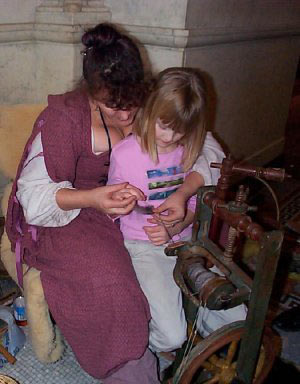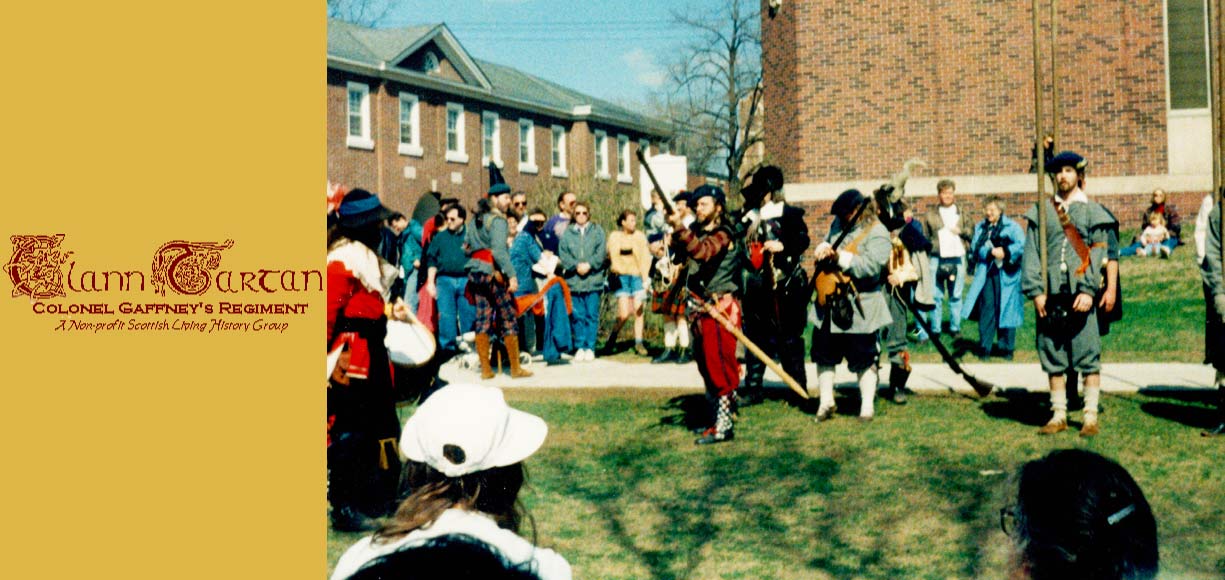Re-Enactment 101
Hello Clann Tartan! I wanted to take some space to talk about the basics. The basics are the essence of our show. They are the general knowledge points of who we are and what we're doing with those pointy sticks. We need to get these "points" across to the majority of the public in small bites they can digest (and will hopefully remember). While the older members already know these things, they need to be repeated from time to time for the newer folks. (and it never hurts to polish your character in the off season!)
We can start with the public. The public in general are fairly harmless and may be caught easily. The best way is to look them in the eye and acknowledge them. A nod of the head will still them most of the time, quickly followed up by "good day, sir ( or mum", as the case may be). Once you've ensnared them in your trap, you may do as you will with them. Remember, whatever mundane task you're doing is interesting and new to them, even carrying water! In an extreme case when you are actually trying something new and have no idea what your doing let alone why, refer the prey to a more experienced member of the pack.
Next, you need to know what to say. You will be more convincing as an interpreter if you are prepared. Enclosed in this newsletter is a cheatsheet with a few basic facts. If you study these points and practice reading them out loud you will be able to speak to the public more easily. ( If you think you are too shy to talk to strangers---see me, I can fix that ). The public needs to be talked to constantly to remain at ease. If they grow disinterested they tend to wander away before they get the full impact of the 17th century.
Listening to other peoples' demonstrations is the best way to learn. Go listen a couple times and get the general knowledge of what they're doing. The next time a patron asks you, "what's he/she doing"?, you will be able to answer as if it were a familiar task in your eyes.
When there is a drill, be prepared to interpret it to the public. Drill draws many people to our camp and we should try to convey the basics to all of them. Talking about drill leads naturally into the overall purpose of our camp and who,when and where we are. From there you may lead them where you will, to the spinning, to the campfire, to the tavern. ( Do not feed them, they are impossible to get rid after that). Taking them to buy pottery is probably the best thing to do. You can never have enough pottery.
And lastly, be respectful of the hierarchy of the camp. The punishment for almost everything is death, and most times SEVERE death. ( If you have any doubts, ask McDuff, McStyre, MacCleod, MacGhillie-Brath, various Ians and, of course, Will Bushmill). When an officer gives you an order, you jump. The Captain is everything to you if you're a soldier. He literally has the right to say if you can breathe. No campfollower would dare intentionally anger him. It would be very unwise in a time when food, clothing, shelter and safety were not to be taken for granted. Understand your role in the camp and how your character would have related to other characters. If you're unsure how to respond to someone, ask them (they usually don't bite---hard). Good character interaction strengthens the illusion of time travel for the patron.
I am sure there are more things to say about the basics. I have covered only a few. These points, though, are ones that I think important. Many of you probably have points or hints to add and I would encourage that you collect them to share. Perhaps you could make your own addition for the cheatsheet for Kali to print in the newsletter.
I would like to thank Charles Knutson for getting me some of information on the cheatsheet. It comes from an old newsletter or orientation flyer, whose purpose was exactly this, covering the basics.
General Welcome/Orientation
-Welcome! In our camp you have not only jumped back in time but across the ocean to Scotland.We portray a mercenary recruiting camp under Col.Gaffney.There are campfollowers and locals with us supplying new and old soldiers with the things that they may need. -The year is 1630, just ten years after the pilgrims landed at Plymouth and the same era as the Three Musketeers-At this time, between ten and twenty thousand Scots will fight as mercenaries in the army of Sweden in the Thirty-Years War.The soldiers being recruited here are re-enforcements for the Swedish army that has just landed in Pomerania, or what you would call northern Germany or Poland.
Kilts
-Our kilts are different from the modern , they're not sewn or stitched,simply six to nine yards of wool,folded and belted at the waist. One of the old names is belted plaid,plaid being Gaelic for blanket.
-It seems odd,but it's very versatile. The extra material can be tucked up for warm weather or wrapped around you in the cold.
-The pattern and color of a plaid in our time was determined by what dyes were available in the area and who produced it. Chiefs or Lairds had only just started having their men wear similar colored tartans in the 1600's. It was not until later that it denoted specific clans.
Pike Drill
-Pikes are a necessary part of warfare in our time. they used them in block formation 36 pikemen across and 6 deep with a block of 94 musketeers on either side.
-Pikes 10 to 18 feet long were used by well trained soldiers in tight "hedgehog" formations, effectively stopping cavalry or advancing on the enemy.
-the invention of the first pike block, first with bow and arrow and later with guns, brought and end to the era of knights in armor. The pike was the equalizer between an army of peasants and the armored nobles of earlier wars.
-This is the end of the era of pikes, they were replaced by the bayonet by the late 1600's.
Musket Drill
-The guns we used were mainly matchlocks, firearms that use a burning rope or "match" for the firing mechanism. The first flintlocks were invented in the 1500's but were not as common or reliable as the matchlock.
-The matchlock was slow to reload and was easily over-run by horsemen. They were used in conjunction with pike and often fired volleys at the enemy rather than shooting for accuracy.
-Matchlocks are powerful enough to kill an unarmored man at 1000 yds., but not accurate.They are a smooth bore barrel as opposed to rifled, which makes the ball or "bullet" bounce out the barrel rather than spin like later weapons.They were generally used within 200 yds. of the enemy.
-Musketeers were not just French. A musketeer was simply a common soldier who carried a musket.
The Camp
-Armies were not the self-sufficient armies of today but relied on civilians to provide many of their needs.
-The camp is made up of people performing various tasks related to the army. They may or may not be members of the regiment.
-Some of the occupations were Tavernkeeper, Sutler, Spinner, Seamstress or Tailor, Musician, Cook, Washerwoman, Herbwoman or Healer, Leatherworker, Woodturner, Horner, Blacksmith, etc. There were both men and women in the camp, which often outnumbered the regiment.
-Only a small number of campfollowers were in the employ of the regiment. The rest traveled with the army for what they could earn plying their trades.
Food
-A basic soldiers ration was salt pork or bacon, cheese, unleavened bread, and ale. Soldiers would supplement their rations with goods to be had from sutlers of the camp.
-The basic grains we ate were oats, barley and rye. Wheat was available but not easily for common folk.
-Things like potatoes and corn come from the Americas and are not widely available until the latter part of the 17th century.
-How much you had to eat depended on what your station in life was. Being with an army was a way to ensure access to food if you were poor or displaced.

